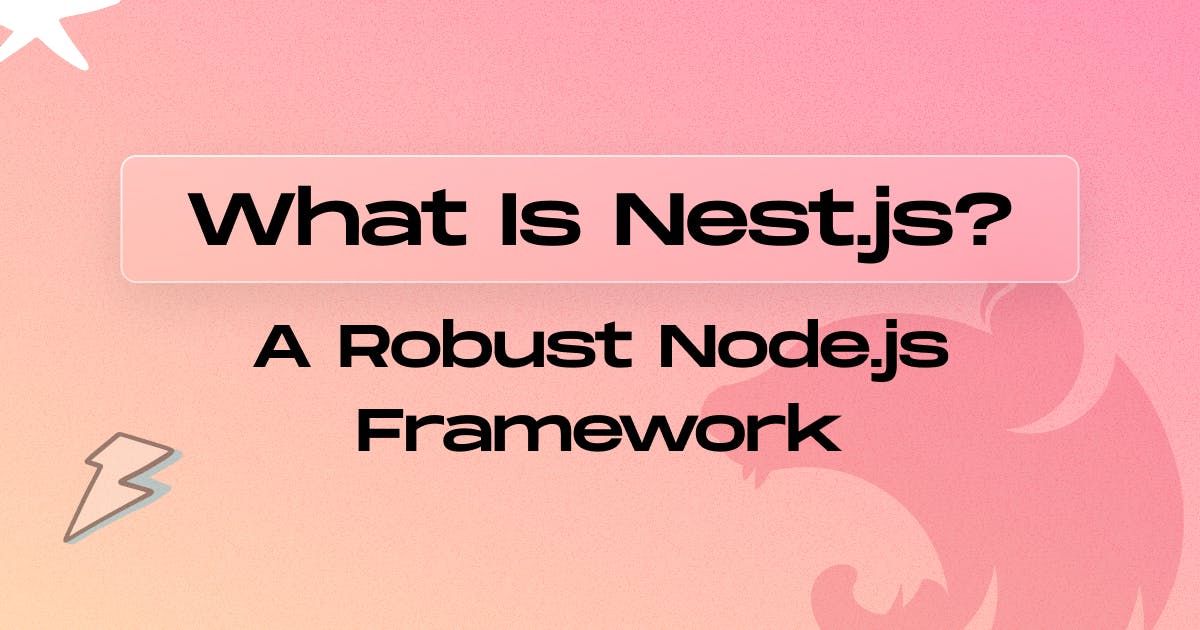August 22, 2024
What Is Nest.js? A Robust Node.js Framework

Nusrat Sarmin

Is your server-side development stuck in the past? It’s time to upgrade your toolkit with a framework designed for modern demands.
Nest.js is revolutionizing the way we build efficient, scalable, and maintainable server-side applications. A cutting-edge framework that’s taking the Node.js world by storm.
Built with TypeScript, Nest.js seamlessly merges object-oriented programming, functional programming, and reactive programming into a single, powerful toolkit.
Read on to discover how the Nest.js framework can transform your development experience and skyrocket your productivity!
What Is Nest.js?

NestJS is a progressive Node.js framework designed by Kamil Myśliwiec. NestJS was first released in 2017. Since then, it has evolved significantly, incorporating new features and improvements to meet the needs of modern server-side development. The framework has gained widespread adoption and support from developers worldwide, contributing to its ongoing development and improvement.
It is built with TypeScript by default, although it also supports JavaScript. Inspired by Angular, NestJS provides a modular architecture that enables developers to organize their code in a more maintainable and scalable way.
It offers a powerful set of tools and features, such as dependency injection, a modular system, and an intuitive CLI. These make it suitable for creating enterprise-grade applications. Additionally, NestJS supports building both RESTful APIs and GraphQL applications, providing a versatile solution for various types of server-side development.
What Is Nest.js Used for?
NestJS is specifically designed to build scalable and maintainable server-side applications. It is particularly well-suited for:
1. Enterprise-Grade Applications: Its modular architecture and support for TypeScript make it ideal for complex, large-scale applications that require robust design patterns and maintainability.
2. RESTful APIs: NestJS provides tools and features to efficiently build and manage RESTful APIs.
3. GraphQL APIs: It has built-in support for GraphQL, allowing developers to create flexible and powerful APIs.
4. Microservices: NestJS offers features and patterns to facilitate the development of microservices architectures.
5. Modular Systems: Its design promotes modularity, which helps in organizing code into manageable, reusable components.
6. Real-Time Applications: Supports real-time capabilities, making it suitable for applications that require real-time communication, such as chat applications or live updates.
7. Event-Driven Applications: Allows for building event-driven architectures, enabling applications to respond to various events efficiently and scalably.
Key Features and Advantages of Nest.js?
✔ TypeScript Support:
Nest.js is built with TypeScript, ensuring a strongly typed development experience. Typescript ensures type safety to prevent runtime errors and enhance code reliability. This leads to better code quality, improved developer productivity, and easier maintenance.
✔ Modular Architecture:
NestJS promotes a modular architecture, which allows developers to organize their code into modules. Each module encapsulates a set of related components, such as controllers, services, and providers.
✔ Dependency Injection:
Nest architecture uses a design pattern called dependency injection (DI). DI means that instead of a class creating its own dependencies, these dependencies are created outside the class and then provided to it when needed. This approach makes the code more modular and easier to maintain.
✔ Asynchronous Programming:
NestJS fully supports asynchronous programming, enabling developers to build non-blocking applications. This capability is crucial for handling multiple connections simultaneously and improving application.
✔ Powerful CLI:
Provides a powerful CLI for project setup, code generation, and development tasks. The CLI speeds up the development process by generating boilerplate code, and setting up new modules, controllers, services, and more, with simple commands.
✔ Decorators:
NestJS uses decorators to add info to classes and methods for routes, middleware, guards, and other features. Decorators make the code more readable and expressive by clearly defining the behavior of classes and methods. For example, @Controller(), @Get(), @Post(), and @Injectable() are some common decorators used in NestJS.
✔ Middleware:
Nest.js supports middleware, which allows developers to define custom functions that can be executed before or after route handlers. This is useful for tasks such as logging, authentication, and error handling.
✔ Interceptors
Interceptors are used to perform actions before or after the route handler is invoked. They can modify request and response objects or transform response data. Inceptors are useful for cross-cutting concerns like logging, auditing, error handling, transforming responses, and response mapping.
✔ Pipes:
Pipes are used for input validation and transformation. They can validate user input data before processing it in the application, ensuring that only valid data is handled by controllers. Pipes help ensure that incoming data is in the expected format and meets certain criteria.
✔ Guards:
Guards are used for authorization purposes. It provides a way to implement access control at the route level, ensuring that only authorized users can access certain resources. They determine whether a given request will be handled by the route handler or not. This decision is based on certain conditions, such as permissions, roles, and ACLs, present at run-time.
✔ Exception Filters:
Nest includes a built-in exceptions layer that processes all unhandled exceptions across an application. Exception filters handle errors thrown within the application effectively. They allow developers to define custom logic for error handling and response formatting.
✔ GraphQL Integration:
NestJS offers robust support for building GraphQL APIs. By leveraging TypeScript, it enables the creation of type-safe resolvers and schemas, significantly enhancing code reliability. This strong integration allows developers to construct flexible and efficient APIs while maintaining code quality through compile-time type checking.
✔ Microservices Architecture:
NestJS natively supports microservice architectures. It provides built-in mechanisms for constructing distributed systems using various transport layers like TCP, Redis, NATS, and MQTT. This flexibility allows developers to create scalable architectures suitable for distributed systems.
✔ Testing:
Nest.js includes built-in testing utilities, making it easier to write unit tests, integration tests, and end-to-end tests for your application. It makes testing components easier with dependency injection and mocking capabilities. The testing utility integrates well with popular testing frameworks like Jest and Supertest.
✔ Integration with Other Libraries:
Nest is platform agnostic. It seamlessly integrates with various libraries and frameworks like TypeORM, Mongoose, Passport, and others. So, developers can leverage existing tools while benefiting from Nest's architecture.
✔ Extensibility
Extensibility in NestJS refers to its ability to be customized and expanded to fit the specific needs of a project. This can be done without compromising the core framework structure and its a key factor in building robust and adaptable applications.
Why Choose NestJS as Your Backend Framework?
NestJS is becoming a popular choice among companies for their backend frameworks, and for good reasons. Here's why leading organizations like Adidas and others are opting for NestJS:
👍 Performance: NestJS is designed to be highly performant, leveraging the non-blocking, asynchronous nature of Node.js. It also ensures efficient handling of HTTP requests. The framework is great for fast apps with low resource usage.
👍 Developer Experience: NestJS prioritizes developer experience by providing a well-structured framework, extensive documentation, and a robust CLI. TypeScript makes coding easier with better tools and analysis. Clear guidelines and tools help new developers work competently.
👍 Scalability: Designed to handle growing application needs, making it suitable for both small and large-scale projects. NestJS provides the tools and patterns needed for scalable application development. The modular architecture, microservices support, and ability to handle a high volume of requests make NestJS highly scalable. These features enable developers to build applications that can grow with increasing demands.
👍 Flexibility: NestJS is highly extensible, allowing you to customize and expand your project without compromising the core framework structure.
👍 Works with Any Frontend Framework: NestJS integrates seamlessly with any frontend framework. As a backend framework, NestJS provides flexible and modular services. It can serve APIs or handle business logic for frontend technologies like React, Angular, Vue.js, or Svelte. By focusing on backend operations, NestJS can effectively support any frontend framework you choose. This facilitates a smooth and efficient connection between the backend and front end of your application.
👍 Extensive Documentation & Community Support: NestJS provides comprehensive and well-maintained documentation, covering all aspects of the framework. Additionally, lots of people using and helping with NestJS. This helps new developers get started quickly, find solutions to problems, and understand best practices.
👍 Rich Ecosystem: NestJS benefits from a rich ecosystem of modules and packages that extend its functionality and provide ready-made solutions for common tasks. This allows developers to quickly add new features and capabilities to their applications without reinventing the wheel.
Why NestJS Is a Strong Backend Choice for JAMstack Sites?
NestJS can be a great choice for a JAMstack-based site, but whether it's "perfect" depends on your specific needs.
In a JAMstack architecture, you typically use static site generators or frontend frameworks to create the user interface. APIs are then relied upon to handle dynamic functionality and data. NestJS can serve as an ideal backend for this setup due to its ability to build robust and scalable APIs. It can handle complex server-side logic, and data management, and provide the necessary endpoints for your JAMstack frontend.
Who’s Using Nest.js?
Nest.js has gained significant traction in the developer community and is used by a variety of companies and organizations to build robust server-side applications. Here are some notable users of Nest.js:
- Adidas
- Capgemini
- Roche
- GitLab
- IBM
- BMW
- Autodesk
- Hinge Health
Getting Started with Nest.js
To get started with Nest.js, you'll need to have Node.js and npm (Node Package Manager) installed on your machine. You can create a new Nest.js project using the Nest CLI (Command Line Interface).
Step 1: Install the Nest CLI:
npm install -g @nestjs/cli
Step 2: Create a new project:
nest new project-name
Step 3: Navigate to the project directory:
cd project-name
Step 4: Run the application:
npm run start
By default, the application will be running on http://localhost:3000
Closing Remarks
Nest.js is a powerful framework for building server-side apps with Node.js. It has a modular design, supports TypeScript, and offers many features, making it a solid choice for scalable and maintainable projects. Whether you're working on a simple API or a complex microservices system, Nest.js gives you the tools and structure you need.
By leveraging Nest.js, you can enjoy the benefits of a modern, TypeScript-first framework. It brings best practices and design patterns from the Angular ecosystem to the server-side world.
Looking for a website that's not only blazing-fast but also custom-fit to meet any challenge? StaticMania is ready to help! Our expert team delivers cutting-edge solutions, including JAMstack strategies, headless CMS integrations, progressive web apps, and e-commerce development. Harness the power of the latest web technologies to transform your online presence.
Don’t settle for the ordinary—let's build something extraordinary together!
FAQ about NestJS
1. What is NestJS?
A Node.js framework for building scalable, server-side applications using TypeScript.
2. Is NestJS frontend or backend?
NestJS is a backend framework. It is designed for server-side development, meaning it handles server logic, database interactions, and API responses. It is not used for building client-side interfaces or user experiences, which are the domain of front-end frameworks and libraries.
3. Can NestJS integrate with other libraries and frameworks?
Yes, NestJS is highly flexible and integrates well with a variety of libraries and frameworks. You can use it with ORMs like TypeORM or Mongoose for database interactions, authentication libraries, and other tools to extend its functionality.
4. What is NestJS used for?
NestJS is used to create robust server-side applications. Common use cases include API Development, Microservices, Real-Time Applications, and Enterprise Applications.
5. Is NestJS suitable for microservices?
Yes, NestJS is well-suited for microservices. It provides built-in support for microservice architectures and various communication strategies, such as TCP, Redis, and NATS, making it easier to build and manage distributed systems.
6. Where can I find help or resources for NestJS?
You can find help and resources through:
- Official Documentation: NestJS Documentation
- Community: Join the NestJS community on GitHub, Reddit, or other forums.
- Tutorials and Courses: Look for online tutorials and courses to learn more about using NestJS effectively.

